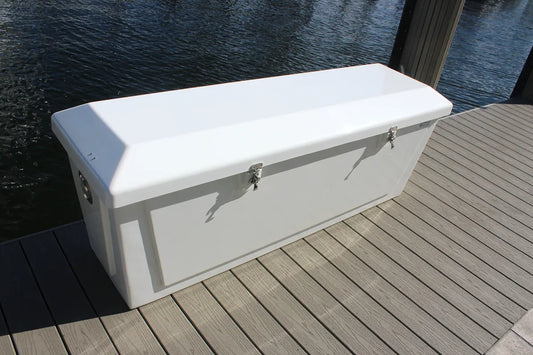DOCK FENDERS
Dock fenders attach to docks and pilings. They absorb impacts from abrupt approaches and the jostling of waves to provide a safe cushion for boats and minimize damage to both contact surfaces. They are also helpful in guiding a boat carefully into its slip.
DOCK FENDERS
-

FEND-OFF DOCK FENDERS
Every boat owner wants to protect their vessel from potential damage...
-

FENDER BRACES
After enjoying a day at Lake Sylvia or Whiskey Creek Hideout inside...
HOW TO CHOOSE THE RIGHT FENDERS FOR YOUR BOAT DOCK
Several factors will influence your choice of fenders. The size of your boat, typical marina conditions, and the dock configuration are all important. Consider the following dock fender qualities to ensure a good fit.
QUALITY
Cheap dock fenders may have attractive upfront prices, but they’ll need to be replaced more often than higher-quality ones. They may also not offer the same level of protection, meaning scratches — or worse — in your hull. As a result, they often end up costing more than high-quality products like FEND-ALL® fenders.
PROFILES
The profile of a dock bumper determines what size vessel it will protect and what location it is best suited for. Our FEND-ALL® fenders are available in several profiles, each one designed for a specific application:
- The FA50 offers a slim profile with excellent protection for smaller vessels.
- The FA201 is designed to provide additional protection for larger vessels.
- The FA250 is a more robust profile designed to handle boats between 25 and 50 feet.
The FA300 corner fenders can handle a wide range of boat sizes.
The FA400 is designed to provide superior protection in narrow spaces.
INSTALLATION LOCATION
You want to ensure that you place dock fenders in locations with a high probability of deck-to-boat contact. For example, pilings in high-traffic areas and slip edges that are vulnerable to impacts from boats are likely to be your primary focus for dock bumper placement.
Once you determine installation locations, you'll want to choose fender shapes best suited to them. Our dock fenders are available in a variety of shapes to allow for easy installation and superior protection:
- 90-degree edge protection
- Curved pile mount
- Flat and P-style edge mount
We also offer fender braces and plastic lumber to ensure dock bumpers installation in all desired locations.
MATERIALS
Various materials are used to make dock and boat bumpers. Each one has advantages and disadvantages. For example, foam and rubber dock bumpers are convenient and lightweight but are also easily damaged and deteriorate quickly.
All FEND-ALL® dock fenders are made with 100% certified prime virgin UV-stabilized flexible PVC. This provides superior protection while resisting the effects of common marine hazards, such as gasoline, oil, and salt. It also has an expected service life of 10 years, so you won't have to worry about replacing your fenders for a while.
BENEFITS OF FEND-ALL® DOCK FENDERS
The FEND-ALL® line offers the ultimate in customizable protection. Dock bumpers are available in six different profiles, several attachment designs, and varying sizes that can be cut to length. Each is also available in black and white to complement your marina design.
SUPERIOR CRAFTSMANSHIP
Our FEND-ALL® dock fenders are made with premium, high quality materials designed to last in a harsh environment. Each is backed by a three-year warranty and an anticipated 10-year life span with proper care. They feature:
- A continuously supported, double-walled design for superior shock absorption
- Patented web design for ultimate protection and durability
- Resistance to marring, gasoline, oil, salt, and marine boring organisms
EASY INSTALLATION
FEND-ALL® dock fenders offer a simple installation process that can often be completed by one person using the following steps:
Measure the following locations:
- The installation area
- The distance between the dock and the water (you do not want the bumper continuously submerged)
- For post dock bumpers, the length and width of the post to ensure a proper fit
Then:
- Cut the dock bumpers to the correct size if needed
- Position the bumpers in their desired location and mark attachment locations
- Predrill holes in the fenders and dock material
- Use stainless steel lags to attach the dock fenders

SIGNS YOU NEED NEW DOCK FENDERS
High-quality dock fenders are designed to last for years without problems. However, they do not last indefinitely. You will need to replace even the best bumpers eventually. When you start to notice the following signs, it's time to invest in new fenders:
- Wear to existing fenders or dock materials
- Rust at attachments
- Cracks in bumper materials or attachment points
- Rotten wood in supports, braces, or adjacent dock material
- Dock or boat damage from repeated contact
- Highly compressed fender material that does not offer adequate shock absorption
- Discoloration from environmental damage or material degradation
NEWS & UPDATES
-

-

Top Dock Float Manufacturers You Should Know
Dock Floats| Dock Manufacturers| Dock Safety|Read moreDock Floats| Dock Manufacturers| Dock Safety|Top Dock Float Manufacturers You Should Know
Read more -








